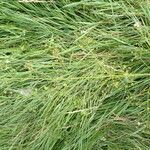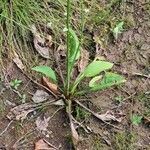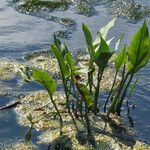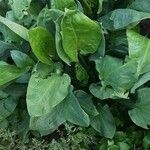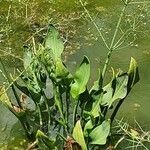Aquatic herb.. Petiole (10–)15–30(–40) cm. long; leaf-blade ovate, (5–)10–15(–25) × (2.5-)5–7(–12) cm.; base rounded to subcordate; nerves 5–9, not all radiating from the apex of the petiole.. Peduncle (2–)6–10 dm. high.. Inflorescence of about 6 whorls of branches and flowers; bracts membranous, lanceolate, those of the lowest whorl 1–2 × 0.5 cm., with several smaller bracteoles.. Pedicels up to 2 cm. long.. Sepals ovate, 2 mm. long.. Petals 4 mm. long, white, delicate.. Stamens 2 mm. long; anthers 0.75 mm. long, narrow; filaments attached above the base.. Carpels ovate, compressed, less than 1 mm. long; style about 1 mm. long, erect or slightly curved.. Achenes broadly ovate, with 2 or 3 ridges on the dorsal surface, pale brown to yellowish.. Fig. 3, p. 6.
Tubers 1-3.5 cm in diam. Aerial leaves with petiole 1.5-30 cm; leaf blade broadly lanceolate or elliptic to ovate, 2-11 × 1.3-7 cm, sometimes larger, veins 5, base subcordate or truncate but sometimes cuneate, apex usually acuminate. Panicles 15-50 cm, in 3-8 whorls of 3-9 branches. Pedicel 1-3.5 cm. Sepals broadly ovate, 2.5-3.5 × 2-3 mm. Petals white or purplish white, suborbicular, larger than sepals, margin denticulate. Anthers elliptic, ca. 1 mm. Carpels regularly arranged; styles erect, filiform, longer than ovary, 0.7-1.5 mm, stigmatose in upper 1/9-1/5 of their length. Achenes elliptic or suboblong, ca. 2.5 × 1.5 mm, 1-or 2-grooved abaxially; lateral pericarp thickish, opaque. Fl. and fr. May-Oct. 2n = 14*.
Stems stout, erect, to 1 m high; rootstock short, stout. Leaves all basal, erect; laminae 8-20 × 3-10 cm, ovate, subacute, rounded or subcordate at base; petiole long. Inflorescence a large, much-branched panicle; branches whorled, ± straight, usually ascending, basally bracteate. Flowers usually pale lilac, c. 1 cm diam., pedicels slender, bracteate; sepals oblong; petals rounded. Achenes c. 20, c. 2.5 mm long, rounded, compressed, in a dense circular head; persistent style from below middle of inner edge of achene, ± straight; stigmatic portion occupying 1/8-1/5 of style-length.
Emergent erect aquatic, perennial or facultative annual, to 1.5 m high. Leaves: petiole to c. 80 cm long, flattened on one side and with small wings at base; blade (lanceolate to) ovate or broadly elliptic, mostly 10–30 cm long and 7–12 cm wide, rounded to cordate at base, with usually 7 prominent parallel veins connected by numerous transverse veins. Inflorescence to 60 cm long, 40 cm wide. Flowers c. 10 mm diam. Sepals to 2 (–3.5) mm long. Petals to 4 (–6.5) mm long, pale pink or almost white. Carpels c. 20; style ± straight. Achenes 2–2.5 mm long, falling singly.
Herbs, to 1 m. Leaves emersed, petiolate; blade linear-lanceolate to broadly elliptic to ovate, to 30 ´ 1--12 cm. Inflorescences to 1 m. Flowers chasmogamous; sepals 1.7--3.2 mm; petals purplish white to purplish pink, 3.4--6.4 mm, margins ± erose, apex obtuse; anthers ellipsoid, 0.7--1.4 mm; style ± straight, 0.6--1.5 mm, exceeding ovary length. Fruiting heads 4--6.5 mm diam; achenes ovoid, 1.7--3.1 mm, abaxial keels broadly rounded, with 1 median abaxial groove, rarely 2, beak erect or nearly erect. 2n = 14 (Eurasian material).
A perennial plant. It emerges from water. It forms tussocks or clumps. It grows up to 90-150 cm high and 45 cm across. Leaves form from the base. The leaf blades are 10-25 cm long and 7-10 cm wide. There are 7 veins which run along the leaf. The leaf stalk is 80 cm long. They are flattened on one side and have wings near the base. The flowers are in an open panicle. This is 60 cm long by 40 cm wide. The flowers are 1 cm across. The petals are pale pink. The fruit is one seeded. It is 2-2.5 mm long.
Annual, occasionally perennial, hydrophyte (hyperhydate), 0.3-1.0 m high. Leaves erect, blade variable, linear-lanceolate to elliptic, base tapering to heart-shaped, apex pointed. Inflorescence compound, consisting of successive whorls of usually > 3 branches. Flowers bisexual. Petals white to purplish pink, yellow spot near base. Stamens 6, in pairs opposite petals. Carpels 10-20 free, borne on a flattened receptacle. Flowering time Nov.-Mar. Fruit laterally compressed nutlets, dorsally ridged.
Perennial, stoloniferous, aquatic herb, up to 1 m high; glabrous. Stems triangular. Leaves petiolate; blade ovate, 150-300 mm long, base rounded to cordate; petioles up to 400 mm long. Flowers: in a much-branched, pyramidal panicle; stamens 6; sepals 3, green; petals larger than sepals, 3 ± 10 mm in diameter, white, pink or purple; Nov.-Mar.
Perennial, stoloniferous, aquatic herb, up to 1 m high. Leaves with lamina ovate, rounded to cordate at base. Petioles up to 400 mm long. Inflorescence a much-branched, pyramidal panicle. Petals larger than sepals. Flowers white or pink.
